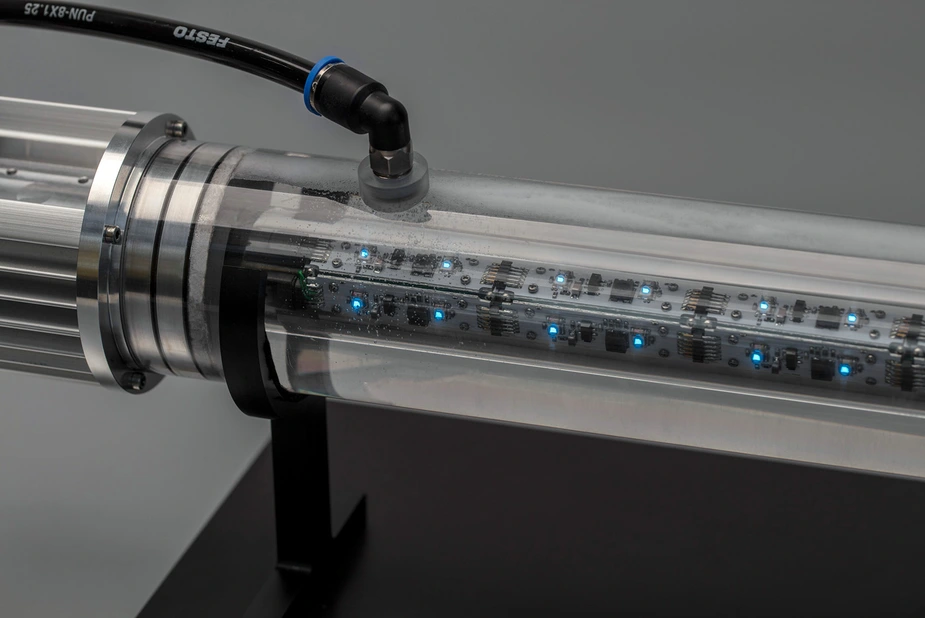From laboratory to everyday life: UVC LEDs for disinfection on the way to widespread use
International research team publishes overview of the state of the art of commercial UVC LEDs
An international team of researchers has, for the first time, comprehensively assessed the state of the art of commercial UVC LEDs and summarized the findings in an open-access review. These compact, efficient, and mercury-free UV light sources are considered a key technology for future disinfection and sterilization systems. The paper provides an overview of the performance and particular characteristics of the technology, offering solid data to help to open up both existing and new UVC applications with LEDs.
Ultraviolet (UV) light can inactivate pathogens on surfaces, in the air, and in water. Light-emitting diodes (LEDs) operating in the UVC spectral range at wavelengths below 280 nanometers are gaining importance thanks to rapid advances in efficiency and lifetime. In contrast to conventional UV lamps, they are extremely compact, dimmable, capable of fast switching, and, most importantly, free of mercury. Researchers from the Ferdinand-Braun-Institut (FBH) in Berlin, together with four other institutions, investigated UVC LEDs from 14 manufacturers over a period of two years, covering devices with wavelengths between 260 and 280 nanometers. The 41-page open-access review provides, for the first time, a comprehensive overview of current performance and reliability, thereby bridging the gap between manufacturer’s and user’s perspective.
“Our data support both manufacturers and end-users in making well-informed decisions for the development and deployment of UVC LED systems,” explains Dr. Jan Ruschel, one of the lead authors and a researcher at FBH.
Applications from water purification to air cleaning
UVC LEDs open up a wide range of everyday applications: from environmentally friendly drinking water treatment and air purification in schools and hospitals to the disinfection of refrigerators, dishwashers, touchscreens, and production facilities in the food industry. In regions without stable power supply, their compact design and low energy requirements enable mobile, solar-powered solutions. Unlike the low-pressure UV lamps that are still commonly used today, UVC LEDs do not contain toxic mercury, show relatively low sensitivity of emission properties to temperature changes, and often have longer lifetimes already.
A guide for manufacturers and users
The now published paper surveys key parameters of UVC LEDs available on the market that are critical for developing disinfection systems. Both lifetime and efficiency vary significantly – depending on operating conditions, design, and manufacturer. The researchers address thermal, optical, and electrical effects, and how these can be influenced through material selection and operating parameters. Among other factors, the package type plays an important role. A particular focus is placed on lifetime studies in the form of long-term stress tests under various conditions. Users who want to integrate UVC LEDs into their systems can use this information to derive how cooling, power control, optics, and LED monitoring should be designed. “With this, we have successfully closed the gap between laboratory research and practical application,” emphasizes Jan Ruschel. “As an application-oriented research institute, it is of special importance to us that innovations truly find their way into real-world use.”
Research partners:
- Ferdinand-Braun-Institut (FBH), Berlin, Germany
- Signify, Eindhoven, The Netherlands
- University of Padua, Padua, Italy
- RTI International, Durham, NC, USA
- Delft University of Technology, Delft, The Netherlands
Contact:
Dr. Aiko Onken
Communications Manager
Ferdinand-Braun-Institut gGmbH, Leibniz-Institut für Höchstfrequenztechnik
Gustav-Kirchhoff-Straße 4, 12489 Berlin
+49 30 6392-58373
pr(at)fbh-berlin.de
www.fbh-berlin.de
Press release FBH, 16.09.2025
